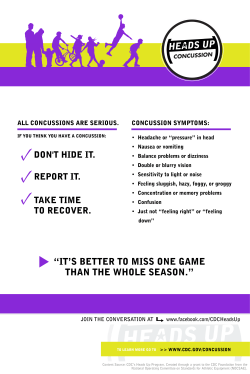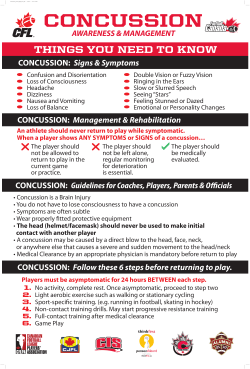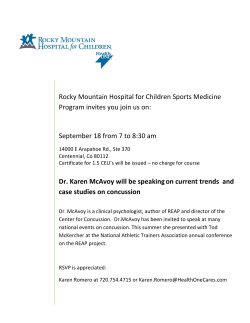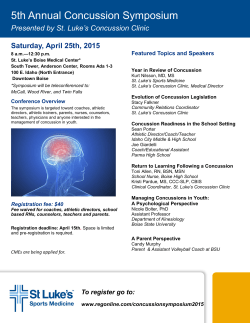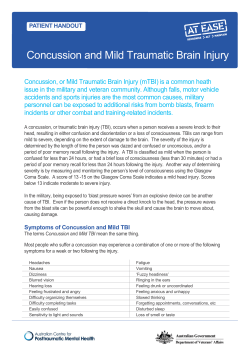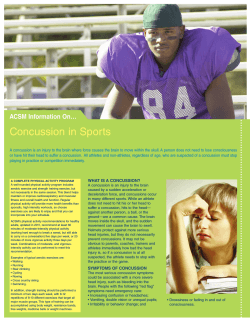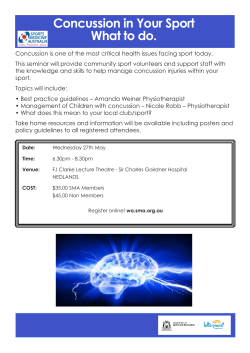
peds20143434_Embargo 1..1
Page 1 of 1 Embargo Copy - Not for Distribution Academic Effects of Concussion in Children and Adolescents Danielle M. Ransom, PsyD, Christopher G. Vaughan, PsyD, Lincoln Pratson, ATC, Maegan D. Sady, PhD, Catherine A. McGill, PsyD, Gerard A. Gioia, PhD (doi: 10.1542/peds.2014-3434) Embargo Release Date: Monday, May 11, 2015 - 12:01 am (ET) Embargo Policy: Information in this article is embargoed for release until the date indicated above. Interviews may be conducted prior to the embargo release date, but nothing may be aired or published. If you are a media representative and have questions about the embargo, upcoming press events, or other matters, please contact AAP Communications staff at 847-434-7877, or via e-mail at commun@aap.org The American Academy of Pediatrics, 141 Northwest Point Blvd., Elk Grove Village, IL 60007 Academic Effects of Concussion in Children and Adolescents Danielle M. Ransom, PsyDa,b, Christopher G. Vaughan, PsyDa,b, Lincoln Pratson, ATCc, Maegan D. Sady, PhDa,b, Catherine A. McGill, PsyDa,b, Gerard A. Gioia, PhDa,b OBJECTIVE: The aim of this work is to study the nature and extent of the adverse academic effects faced by students recovering from concussion. abstract A sample of 349 students ages 5 to 18 who sustained a concussion and their parents reported academic concerns and problems (eg, symptoms interfering, diminished academic skills) on a structured school questionnaire within 4 weeks of injury. Postconcussion symptoms were measured as a marker of injury severity. Results were examined based on recovery status (recovered or actively symptomatic) and level of schooling (elementary, middle, and high school). METHOD: RESULTS: Actively symptomatic students and their parents reported higher levels of concern for the impact of concussion on school performance (P , .05) and more school-related problems (P , .001) than recovered peers and their parents. High school students who had not yet recovered reported significantly more adverse academic effects than their younger counterparts (P , .05). Greater severity of postconcussion symptoms was associated with more school-related problems and worse academic effects, regardless of time since injury (P , .001). CONCLUSIONS: This study provides initial evidence for a concussion’s impact on academic learning and performance, with more adverse effects reported by students who had not yet recovered from the injury. School-based management with targeted recommendations informed by postinjury symptoms may mitigate adverse academic effects, reduce parent and student concerns for the impact of the injury on learning and scholastic performance, and lower the risk of prolonged recovery for students with active postconcussion symptoms. a Children’s National Health System, Washington, District of Columbia; bThe George Washington University School of Medicine, Washington, District of Columbia; and cThe Brody School of Medicine at East Carolina University, Greenville, North Carolina Drs Ransom, Gioia, Vaughan, Sady, and McGill and contributed to study conception; Drs Vaughan, Sady, McGill, and Gioia contributed to creation of the CLASS; Drs Ransom, Vaughan, Sady, McGill, and Gioia collected the data; Mr Pratson assisted with data acquisition; Dr Ransom performed data analyses; Drs Vaughan, Sady, and Gioia and Mr Pratson assisted with data analyses; Drs Ransom, Vaughan, Sady, and Gioia directed the organization of the article; Dr Ransom drafted the article; Drs Vaughan, Sady, McGill, and Gioia and Mr. Pratson provided editorial feedback; and all authors reviewed and approved the final manuscript as submitted and agree to be accountable for all aspects of the work. www.pediatrics.org/cgi/doi/10.1542/peds.2014-3434 DOI: 10.1542/peds.2014-3434 Accepted for publication Mar 5, 2015 Address correspondence to Gerard A. Gioia, PhD, Division of Neuropsychology, Children’s National Health System, 15425 Shady Grove Road, Suite 350, Rockville, MD 20850. E-mail: ggioia@ childrensnational.org WHAT’S KNOWN ON THIS SUBJECT: Concussion produces a range of symptoms that may impede academic functioning. The need for empirical validation exists, despite growing consensus on the importance of a guided return-to-school process for students recovering from concussion. WHAT THIS STUDY ADDS: This study provides initial evidence of a concussion’s adverse effects on academic learning and performance across all grades, including heightened levels of schoolrelated concern and amplified postinjury academic difficulties experienced by symptomatic students relative to their recovered peers. PEDIATRICS (ISSN Numbers: Print, 0031-4005; Online, 1098-4275). Copyright © 2015 by the American Academy of Pediatrics PEDIATRICS Volume 135, number 6, June 2015 ARTICLE There is growing recognition that a concussion can adversely affect children and adolescents across the various aspects of their lives, including home, school, social relationships, and sports/recreation. The 2013 clinical report of the American Academy of Pediatrics highlighted the potential vulnerabilities of postconcussion academic functioning, providing a framework for multidisciplinary care to support recovering students.1 Despite growing consensus on the importance of a guided return-toschool process, there has been no empirical research on which to base specific recommendations. Qualitative reports have illustrated a dynamic process whereby postconcussion symptoms such as headaches, fatigue, impaired concentration, and slowed processing speed have the potential to impede academic performance.2 Students may require a brief absence from school initially during a heightened symptomatic state,3 temporarily interfering with their ability to keep pace with the curriculum. Furthermore, efforts to engage acutely in challenging cognitive activities may lead to worsened symptoms (ie, cognitive exertion effects), which could, in turn, interfere with learning or lead to more school absences.4 High school students may manifest more significant postinjury school difficulties, given the greater demand for balancing the breadth and depth of the academic curriculum alongside extracurricular activities, in comparison with students in earlier grades. Standardized protocols have been recommended for returning to sports, as outlined in recent guidelines from the International Conferences on Concussion in Sport5 and the American Academy of Neurology.6 In contrast, there is no expert consensus on a protocol for return to school during concussion recovery, although 2 several stepwise approaches have been proposed.7,8 Poorly specified or inconsistent recommendations across providers and a lack of standard communication channels between medical teams and school personnel may contribute to adverse postinjury academic effects. It is imperative that any standardized protocol of postinjury academic recommendations is predicated on an empirically based understanding of the academic effects of concussion, not just speculation. By examining the frequency and types of academic issues faced by students during concussion recovery, and what students are most affected, evidencebased standards can be developed for guiding the return to school. This paper seeks to answer the following question: What is the nature and extent of academic effects in symptomatic students who have sustained concussions? We examine school-related effects in students who are actively symptomatic presenting to a specialty concussion clinic compared with students who have recovered from concussion. We first explore the level of student and parent concern about the injury’s potential effects on academic learning and performance. Next, we investigate the specific types of academic problems and affected classes experienced by the injured student. Finally, we study the relationship of postconcussion symptom severity to these academic outcomes. Two primary hypotheses were proposed as follows: 1. Symptomatic students and their parents will report greater injuryrelated academic effects than their recovered peers. a. Postinjury challenges will manifest in higher levels of concern for the impact on school performance, more school-related problems, and a higher number of classes posing greater difficulty compared with concussed students who have recovered. b. Adverse academic effects will be reported by a higher frequency of symptomatic high school students relative to symptomatic middle and elementary school students. 2. Greater severity of postconcussion symptoms will be related to higher levels of concern and more schoolrelated problems. METHODS Participants The sample consisted of 349 youths aged 5 to 18 years who underwent an initial evaluation in an outpatient concussion clinic at a large regional medical center. Parent-child pairs comprised 69% of participants (n = 239), whereas reports from parents alone comprised the remaining 31% of the sample (n = 110). Participants were included if the evaluation took place within 28 days postinjury and the student had returned to school. Diagnosis of concussion was confirmed using the published criteria of the Centers for Disease Control and Prevention.9 Two groups were defined by clinicians based on recovery status at the time of the clinic visit: (1) actively symptomatic/not yet recovered (Rc–), as defined by elevated symptoms and/or impaired performance on neurocognitive testing, and (2) recovered (Rc+), as defined by no elevation of symptoms and no impairments on neurocognitive test performance. Measures Postconcussion symptoms were assessed using parent report and age-specific self-report forms of the Post-Concussion Symptom Inventory (PCSI), adjusted by subtracting retrospective baseline (RBL) ratings of preinjury symptom report from postinjury report.10 The majority of participants underwent a battery of neurocognitive tests (paper/pencil RANSOM et al tests of working memory and response speed; ages 5 to 12: Multimodal Assessment of Cognition & Symptoms for Children; ages 13 to 18: Immediate Post Concussion Assessment and Testing). Students and parents each completed the Concussion Learning Assessment and School Survey (CLASS) to measure postinjury academic experiences (see Supplemental Appendix 1 and 2). CLASS assesses (1) concern for the injury’s effect on school learning and performance (response options: none, mild, moderate, high); (2) new or exacerbated postconcussion academic problems; and (3) perceived impact on academic performance (eg, decline in grades, ability to learn). Parentreported data were collected for the full age range. Children ,10 years of age were not asked to complete CLASS owing to reading/language limitations. Data were retained for analyses if 80% of the questions were completed on each of the questionnaires. Procedure Data were collected as part of a neuropsychological test battery conducted during the patient’s first clinical visit. Data were collected under institutional review board approval, with informed consent obtained from parents and assent from children and adolescents. Analyses were performed with SPSS statistical software, version 22 (IBM Corp., Armonk, New York). As a validity check of the recovery status of the two groups, one-way and repeated measures analyses of variance (ANOVAs) were used to compare RBL and postinjury ratings on the PCSI. One-way ANOVA was used to compare the percent and frequency of neurocognitive scores falling 1.5 SDs below the mean of the normative sample. Participants within each recovery group were further stratified based on level of schooling (grades K through 5 for elementary school, 6 through 8 for middle school, and PEDIATRICS Volume 135, number 6, June 2015 9 through 12 for high school) to examine hypothesized grade level differences. Study hypotheses were examined by using x2 statistics to examine group differences in the type and frequency of academic problems, trouble with classes, levels of concern, and grade status/ change. Univariate ANOVA with a Bonferroni correction for multiple comparisons was used to compare group differences in mean reported academic problems, mean number of classes that pose greater difficulty, and total symptoms. Pearson correlations were used to examine the relationship between total number of postinjury academic problems and concussion symptoms. RESULTS Description of Study Groups Within the Rc+ group, there were no significant differences in self-reported symptom ratings on the PCSI. Statistically significant differences were observed in Rc+ parent report and RBL ratings between groups; therefore, adjusted symptom scores were computed for analyses. Within the Rc– group, there were significant elevations in postinjury symptom ratings relative to RBL ratings, confirming subjects’ symptomatic status. There were significant differences in performance between groups on neurocognitive measures (P , .001), with the Rc– group demonstrating higher frequency of impaired neurocognitive scores than the Rc+ group (Table 1). Demographic characteristics varied between groups, with significantly more males and older children in the Rc+ group and more whites in the Rc– group (Table 2). Gender, age, and race were not related to the academic outcome measures and were not included as predictors in subsequent analyses. Preinjury- and injuryrelated characteristics were consistent between groups (Table 2). Postconcussion Concerns and Academic Effects Student and parent responses to the question, “How concerned are you about this injury affecting (your/your child’s) school learning and performance?” are summarized in Table 3. Significant differences in the reported level of concern were found based on recovery status and level of schooling. Students and parents in the Rc– group reported higher levels of concern (59% of students and 64% of parents reported feeling moderately or very concerned) than students (16%) and parents (30%) in the Rc+ group (P , .001). Within the Rc– group, the level of concern reported by students varied across the three levels of schooling, with more high school students reporting feeling moderately or very concerned (67%) than middle school (52%) or elementary school (38%) students (P , .05). Parents of students in the Rc– group reported generally consistent levels of concern across the three levels of schooling. Within the Rc+ group, more parents of high school students reported feeling moderately to very concerned (45%) than parents of middle school (17%) and elementary school (18%) students (P , .001). There were no differences in self-reported concern across the levels of schooling in the Rc+ group. Student Report of Postconcussion School Problems Student responses to the question, “What kinds of school problems are you having since your injury?” selected from a list of seven common complaints following concussion are reported in Table 4. Significant differences were found in the number and type of school problems reported between students in the Rc+ and Rc– groups. Significantly more postinjury school problems were reported by students in the Rc– group compared with the Rc+ group (P , .001, Cohen’s d = 1.54). Students in the Rc+ group reported a consistent 3 TABLE 1 Parent- and student-reported symptom ratings and postinjury neurocognitive test performance Ratings and Performance Rc+ Rc– n Preinjury (RBL) Postinjury P h n Preinjury (RBL) Postinjury P h2 33 58 100 2.21 (2.43)b 4.12 (5.23)c 4.62 (7.75)d 2.68 (2.88) 4.30 (5.49) 6.30 (8.38) .39 .79 .003 0.02 0.001 0.08 60 152 225 5.41 (5.14)b 7.08 (7.43)c 6.54 (7.05)d 10.51 (5.89) 27.53 (19.11) 28.64 (21.90) ,.001 ,.001 ,.001 0.41 0.56 0.55 104 — 6 — — 235 — 17 ,.001f — — — — — — — — — (23) (11) (4) (2) — — — — — — — — — — — — — — — — (55) (32) (19) (11) ,.001 ,.001 ,.001 .006 — — — — 2 a Symptom ratings Student report: ages 8 to 12 Student report: ages 13 to 18 Parent report: ages 5 to 18 Neurocognitive performancee Percentage of impaired scores Frequency of impaired scores 1 2 3 $4 24 11 4 2 129 75 45 26 Values are expressed as mean (SD) or n (%). a Parent- and student-reported PCSI Total Symptom scores included retrospective report of preinjury symptoms and current postinjury symptoms obtained during the clinic visit. Measures included the 17-item PCSI-SR8 for 10- to 12-year-olds, 21-item PCSI-SR13 for 13- to 18-year-olds, and 20-item PCSI-P for parents. Students aged 8 to 12 reported symptoms on a Guttmann scale ranging from 0 to 2 (PCSI-SR8 ), and students aged 13 to 18 (PCSI-SR13 ) and their parents (PCSI-P ) reported symptoms on a Guttmann scale ranging from 0 to 6. b PCSI self-report ages 8 to 12, P = .001, Cohen’s d = 0.79. c PCSI self-report ages 13 to 18, P , .05, Cohen’s d = 0.46 d PCSI parent report, P , .05, Cohen’s d = 0.26. e Impaired scores were defined as performance on computer and paper-and-pencil administered measures falling 1.5 SDs below the mean of the normative sample. f Cohen’s d = 0.61. number of problems regardless of level of schooling; in contrast, differences were found across levels of schooling among students in the Rc– group (P , .05). Post hoc comparisons revealed that high school TABLE 2 Demographic and injury characteristics for the sample groupsa Characteristic Rc+ Rc– n Age, years Male White Hispanic Maternal years of education Anxiety Depression Attention deficit/hyperactivity disorder Preinjury history of learning disability Preinjury academic supports (504/IEPb) Enrolled in public school Level of schooling Elementary (grades K through 5) Middle School (grades 6 through 8) High School (grades 9 through 12) Preinjury school performance Below average Above average Preinjury history of migraine Preinjury history of nonmigraine headache History of previous concussion Injury cause: sport-related concussion Injury characteristics Loss of consciousness No recall of impact Retrograde amnesia Anterograde amnesia Days since injury 109 13.22 (3.23) 87 (80) 58 (53) 7 (10) 15.93 (2.68) 3 (3) 1 (,1) 7 (6) 6 (6) 10 (9) 67 (61) 240 13.95 (2.75) 147 (61) 165 (69) 18 (12) 16.12 (2.46) 19 (8) 8 (3) 24 (10) 11 (5) 32 (13) 158 (66) 29 (27) 30 (28) 50 (45) 42 (18) 78 (32) 120 (50) 4 55 1 9 34 73 (4) (50) (,1) (8) (31) (68) 5 144 6 27 85 172 13 24 15 24 16.83 (12) (22) (14) (22) (5.61) 25 71 38 54 16.42 P .03 .001 .001 .60 .58 .06 .13 .20 .77 .23 .44 .14 .16 (2) (60) (3) (11) (35) (72) .31 .43 .37 .38 (11) (30) (16) (23) (5.86) .71 .15 .64 .95 .54 Values are expressed as mean (SD) or n (%). a Preinjury demographic, diagnostic, and academic history were reported by parents at the time of the evaluation. b Section 504 of the Rehabilitation Act; IEP, Individuals with Disabilities Education Act. 4 (Cohen’s d = 0.67) and middle school (Cohen’s d = 0.44) students in the Rc– group reported more school problems compared with elementary students, whereas reports from high school and middle school students did not vary significantly. Differences in the type of school problems were also found between groups. Specifically, 88% of students in the Rc– group reported $1 school problems related to symptoms interfering (eg, headaches, fatigue, problems concentrating) and 77% reported diminished academic skills (eg, difficulty taking notes, spending more time on homework, problems studying), in comparison with a minority of students in the Rc+ group (38% and 44%, respectively). Across levels of schooling, in the Rc+ group, the total number of both symptom-interfering effects and diminished academic skills was consistent. In the Rc– group, students reported consistent total interfering symptoms across levels of schooling; in contrast, report of the number of diminished academic skills varied. High school students in the Rc– group endorsed a greater number of problems with academic skills than middle school (P , .01, Cohen’s RANSOM et al TABLE 3 Parent- and student-reported concern for the impact of concussion on school learning and performance Level of Concern Parent Report Rc+ Student Report Rc– P Rc+ Rc– P Rc–, by School Level Elementary None Mild Moderate High 41 33 22 9 (39) (31) (21) (9) 19 66 79 69 (8) (28) (34) (30) ,.001 NS NS .01 32 15 7 2 (57) (27) (13) (4) 15 59 76 30 ,.001 NS ,.01 ,.05 (8) (33) (42) (17) 2 8 6 0 P Middle (13) (50) (37) (0) 8 23 28 6 (12) (36) (43) (9) High 5 28 42 24 (5) (28) (42) (24) NS NS NS .05 Values are expressed as n (%). NS, not significant. d = 0.38) and elementary (P , .01, Cohen’s d = 0.83) students, whereas reports from middle school students were not different from elementary students. recovery status groups, with Rc– group students and their parents reporting significantly more trouble compared with Rc+ group students (P , .001, Cohen’s d = 1.24) and parents (P , .001, Cohen’s d = 1.36). Effects on Classes and Grade Performance Across levels of schooling, Rc+ students and parents endorsed consistent types and number of classes posing greater difficulty; in contrast, Rc– group student and parent responses varied by level of schooling. High school and middle school students and parents in the Rc– group reported trouble in significantly more classes than elementary school students (Cohen’s d = 1.02 and 0.93, respectively) and parents (Cohen’s d = 0.57 and 0.89, respectively) (P , 0.01). Math class was reported as the most problematic subject consistently across grade levels, followed by reading/language arts, science, and social studies. Student and parent responses to the question, “Which classes/subjects (are you/is your child) having trouble with since your injury?)” are summarized in Table 5. Significant differences were found based on recovery status in the number of classes reported to pose greater difficulty during concussion recovery (P , .001). Students in the Rc+ group and their parents were significantly less likely to report trouble in $1 class than Rc– students (P , .001), although nearly half of Rc+ students (48%) and one-third of their parents reported trouble in $1 class during concussion recovery. The total number of classes reported to pose greater difficulty differed between Student and parent responses to the question, “Have (your/your child’s) grades been affected (dropped)?” are reported in Table 5. The perceived effect on school grades was significantly different between recovery status groups (P , .001). Specifically, the large majority of students and parents in the Rc– group reported that they believed grades in $1 academic subject had been affected or may be affected after concussion, whereas fewer than half of the students or parents in the Rc+ group reported a change in grades. No differences in the perceived effect on grades were found across levels of schooling for either recovery status group. Relationship of Postconcussion Symptoms to Academic Effects The relationships between postconcussion symptom severity and level of academic concern, perceived impact on school grades, and the number of postinjury academic problems (Table 6) varied by respondent and level of schooling. TABLE 4 Student report of new or worsened school problems during concussion recovery Report Rc+ Rc– P Rc–, by School Level Elementary Middle P High a School-related problems Symptom-interfering effects Headaches interfering Problems paying attention Feeling too tired Total symptom-interfering effect Diminished academic skills Increased time spent on homework Difficulty understanding material Difficulty studying Difficulty taking class notes Total diminished academic skills Total reported problems 5 8 11 0.50 (10) (17) (23) (0.77) 121 106 95 1.86 (70) (61) (55) (1.04) ,.001 ,.001 ,.001 ,.001 9 8 9 1.52 (53) (47) (53) (1.12) 43 34 36 1.91 (73) (58) (61) (0.97) 69 64 50 1.89 (71) (66) (52) (1.06) .27 .26 .51 .18 10 3 10 4 0.56 1.06 (21) (6) (21) (8) (0.71) (1.19) 94 84 75 0.47 1.73 3.60 (55) (49) (44) (27) (1.32) (2.01) ,.001 ,.001 ,.001 .002 ,.001 ,.001 6 5 3 3 1.00 2.53 (35) (29) (18) (18) (1.17) (2.09) 28 27 21 10 1.46 3.37 (48) (46) (36) (17) (1.28) (1.72) 60 53 51 34 2.03 3.92 (63) (54) (53) (35) (1.29) (2.09) .05 .16 .01 .03 .05 .03 Values are expressed as mean (SD) or n (%). a Frequencies of symptom-interfering and diminished academic skills reported in this table refer to the number of students who endorsed $1 of each school related problem. PEDIATRICS Volume 135, number 6, June 2015 5 TABLE 5 Student and parent report of class difficulties and perceived impact on grades during concussion recovery Report Rc+ Rc– P Rc–, by School Level Elementary Parent report Trouble with one or more classes Math Language Arts Science Social Studies Total classes posing greater difficulty Grades affected? No Yes Not yet Student report Trouble with one or more classes Math Language Arts Science Social Studies Total classes posing greater difficulty Grades affected? No Yes Not yet 25 13 9 5 2 0.45 (27) (14) (10) (5) (2) (0.84) 159 113 94 68 64 2.29 74 (70) 7 (7) 25 (23) 24 15 6 5 6 0.84 (48) (33) (13) (11) (13) (0.98) 36 (67) 7 (13) 11 (20) (75) (53) (44) (32) (30) (1.72) ,.001 .009 ,.001 ,.001 ,.001 ,.001 64 (28) 45 (20) 119 (52) ,.001 ,.05 ,.01 160 114 83 55 47 2.45 ,.001 ,.001 ,.001 .003 .04 ,.001 (90) (68) (49) (33) (28) (1.55) 24 14 17 4 3 1.45 53 39 27 22 20 2.32 16 (40) 5 (13) 19 (47) 16 7 6 0 4 1.30 ,.001 NS .05 46 (27) 41 (24) 85 (49) (63) (37) (45) (11) (8) (1.77) Middle (77) (56) (39) (31) (29) (2.06) P High School 82 60 50 42 41 2.57 17 (22) 14 (18) 45 (59) (70) (41) (35) (0) (24) (1.11) 54 38 22 19 11 2.53 6 (35) 2 (12) 9 (53) (95) (68) (39) (35) (20) (1.50) (78) (57) (47) (40) (39) (2.14) 31 (28) 26 (23) 55 (49) 90 69 55 36 32 2.68 23 (38) 14 (23) 24 (39) .17 .09 .53 .005 .002 .002 NS NS NS (93) (72) (58) (39) (34) (1.57) 17 (18) 25 (27) 52 (55) .001 .05 .04 .008 .16 .002 NS NS NS Values are expressed as mean (SD) or n (%). NS, not significant. Symptom severity was significantly related to level of concern for the injury affecting learning and was related to a perceived impact on school grades when reported by parents or adolescents (P , .001), but not 10- to 12-year-old students. This finding was not changed by time since injury or across recovery status groups. Parents and 13- to 18-yearold students who reported moderate or high levels of concern endorsed a significantly greater severity of symptoms than parents and students who reported no concern or a mild level of concern. Similarly, parents and adolescent students who believed that grades had been or may be affected reported significantly greater severity of symptoms compared with students who denied a change in grades (P , .001). Symptom severity was positively correlated with the total number school problems reported by students and parents (P , .001) (Table 7). Cognitive, physical, and sleep symptom subscales demonstrated moderate relationships with total school problems reported by parents and 13- to 18-year-old students. Parent symptom report of mood/ emotional symptoms was positively TABLE 6 Parent- and student-reported symptom ratings by perceived impact on grades and level of concern PCSIa Adjusted Total Score Impact Parent Report Ages 5 to 18 Grades affected? No Yes Not yet Level of concern None Mild Moderate High P n (%) PCSI, mean (SD) 130 (16) 49 (41) 139 (43) 4.81 (11.10) 23.36 (18.25) 22.28 (19.66) 0.89 9.03 19.40 30.20 59 93 94 77 (18) (29) (30) (23) Student Report (3.26) (12.42) (18.19) (20.61) b Pb Ages 10 to 12 n (%) PCSI, mean (SD) ,.001 .70 23 (51) 10 (21) 13 (28) 3.08 (6.23) 4.57 (3.73) 3.11 (6.92) ,.001 ,.001 ,.001 11 21 16 1 0.90 3.99 4.20 9.75 (24) (44) (34) (,1) (4.27) (6.22) (6.24) (–) Pb Ages 13 to 18 n (%) PCSI, mean (SD) .99 .57 53 (32) 37 (23) 74 (45) 4.06 (10.14) 18.72 (18.66) 20.00 (18.26) ,.001 .69 .15 .34 .36 33 51 62 28 3.08 9.27 19.42 28,66 ,.001 ,.001 ,.01 (19) (30) (36) (15) (9.80) (14.00) (16.78) (19.92) a Parent- and student-reported PCSI Adjusted Total Symptom scores included retrospective report of preinjury symptoms and current postinjury symptoms obtained during the clinic visit. Measures included the 17-item PCSI-SR8 for 10- to 12-year-olds, 21-item PCSI-SR13 for 13- to 18-year-olds, and 20-item PCSI-P for parents. Students aged 8 to 12 reported symptoms on a Guttmann scale ranging from 0 to 2 (PCSI-SR8 ) and students aged 13 to 18 (PCSI-SR13 ) and their parents (PCSI-P) reported symptoms on a Guttmann scale ranging from 0 to 6. b Statistical significance refers to comparisons with the preceding row (ie, no versus yes, yes versus not yet; none versus mild, mild versus moderate, moderate versus high). 6 RANSOM et al TABLE 7 Pearson correlations between parent- and student-reported symptom ratings and the total number of postinjury school problems Number of Postinjury School Problems Parent Report Ages 10 to 18 n PCSI symptom subscale Cognitive symptom subscale Physical symptom subscale Sleep symptom subscale Emotional symptom subscale Total PCSI symptoms 214 r 0.411 0.480 0.468 0.230 0.497 Student Report P Ages 10 to 12 ,.001 ,.001 ,.001 .01 ,.001 48 r 0.457 0.268 0.499 -0.085 0.332 P Ages 13 to 18 P ,.001 .065 ,.01 .081 .023 162 r 0.587 0.544 0.487 0.070 0.577 ,.001 ,.001 ,.001 .38 ,.001 Values are expressed as r. correlated with school problems (P , .01), whereas this relationship was not found for students. DISCUSSION symptoms was directly related to the extent of school-related effects experienced by students at all grade levels, regardless of the length of time since injury. Characterizing the nature and extent of postconcussion academic effects is fundamentally important to guide school-based treatment recommendations. This study examined school-related effects during concussion recovery, finding support for the two study hypotheses: (1) that symptomatic students and their parents would report greater postinjury academic difficulties along a number of lines, with more widespread effects reported by students in higher grade levels, and (2) that greater symptom severity would be associated with more adverse academic effects. The first hypothesis was supported in that symptomatic students and their parents, compared with recovered students, reported higher levels of concern for the adverse effect on learning and school performance, increased school-related problems, and more classes posing difficulty following concussion. Reports from high school students reflected a particular vulnerability to schoolrelated difficulties relative to elementary and middle school students. The second hypothesis, positing a relationship between postconcussion symptoms and academic outcome, was supported in that the severity of concussion A number of implications can be drawn from these findings, informing practical recommendations for students recovering from concussion. The high level of concern about postinjury school performance implies the need to deliver early reassurance to students and families that their academic needs will be met. Furthermore, the range of reported postinjury school problems (eg, increased time spent on homework, headaches interfering with learning) suggests the need to provide actively symptomatic students with targeted supports during the postinjury recovery period. Our findings suggest that these supports are particularly necessary for older students, who face greater academic demands relative to younger peers. Adverse postinjury academic effects (eg, failure to complete schoolwork, problems keeping pace with an expanding workload, perception of poorly controlled symptoms) with no supports may be linked to the onset of depression and anxiety.2,11 These potential negative outcomes might be mitigated by constructing a symptomrelevant set of accommodations in the acute stage of recovery, with school personnel implementing, monitoring, and adjusting supports through recovery. This collaborative sets of PEDIATRICS Volume 135, number 6, June 2015 individualized supports may reduce postinjury morbidities and the risk of prolonged recovery.8 Although future research is warranted to identify specific, evidence-based supports, the association between symptoms and adverse academic effects reported in this study highlights the key role of the medical-school partnership in guiding a successful return to school. In this study, data on academic effects were based on student and parent reports, without objective confirmation from school records (eg, actual changes in grades). Factors such as student or parent anxiety may have inflated symptom reports and concerns, but likely manifested uniformly with little effect on the strength of the relationship with reported academic issues. In addition, the wording of the questions “since (your/your child’s) injury” may have elicited retrospective reports of academic effects that had resolved by the time of the clinic appointment. For example, a minority of children and adolescents who were identified as recovered may have, nevertheless, reported school problems no longer relevant to their injury. In addition, this study sampled only students and their parents who sought specialized evaluation and treatment of this injury, possibly reflecting a more affected sample. Finally, our group comparisons were limited to a clinical sample and did not include an uninjured contrast group, compared to whom differences may be even greater than those found between recovered and symptomatic students. CONCLUSIONS This study provides initial evidence of a concussion’s effects on academic learning and performance across all grades, including student and parent report of the nature and extent of school concerns and range of postinjury problems. Medical-school partnerships can facilitate a targeted 7 approach to school-based management for students with active concussion symptoms, minimizing the potential for adverse academic effects and postinjury morbidities. Based on this model, future research can inform evidence-based academic management strategies, mitigate postconcussion academic effects, reduce parent and student postinjury concerns, and expedite recovery following concussion. FINANCIAL DISCLOSURE: The authors have indicated they have no financial relationships relevant to this article to disclose. FUNDING: No external funding. POTENTIAL CONFLICT OF INTEREST: The authors have indicated they have no potential conflicts of interest to disclose. REFERENCES 1. Halstead ME, McAvoy K, Devore CD, Carl R, Lee M, Logan K; Council on Sports Medicine and Fitness; Council on School Health. Returning to learning following a concussion. Pediatrics. 2013;132(5): 948–957 2. Sady MD, Vaughan CG, Gioia GA. School and the concussed youth: recommendations for concussion education and management. Phys Med Rehabil Clin N Am. 2011;22(4):701–719 3. Halstead ME, Walter KD; Council on Sports Medicine and Fitness; American Academy of Pediatrics. Clinical report— sport-related concussion in children and adolescents. Pediatrics. 2010;126(3): 597–615. Available at: www.pediatrics. org/cgi/content/full/126/3/e597 4. Majerske CW, Mihalik JP, Ren D, et al. Concussion in sports: postconcussive activity levels, symptoms, and 8 neurocognitive performance. J Athl Train. 2008;43(3):265–274 5. McCrory P, Meeuwisse WH, Aubry M, et al. Consensus statement on concussion in sport: the 4th International Conference on Concussion in Sport held in Zurich, November 2012. Br J Sports Med. 2013;47(5):250–258 6. Giza CC, Kutcher JS, Ashwal S, et al. Summary of evidence-based guideline update: evaluation and management of concussion in sports: report of the Guideline Development Subcommittee of the American Academy of Neurology. Neurology. 2013;80(24):2250–2257 7. McAvoy K. REAP the Benefits of Good Concussion Management. Centennial, CO: Rocky Mountain Sports Medicine Institute Center for Concussion; 2009. Available at: http://issuu.com/healthone/ docs/reap_oct21. Accessed June 9, 2014 8. Gioia GA. Medical-school partnership in guiding return to school following mild traumatic brain injury in youth [published online ahead of print August 8, 2011]. J Child Neurol. doi:10.1177/ 0883073814555604 9. Nonfatal Traumatic Brain Injuries Related to Sports and Recreation Activities Among Persons Aged #19 Years—United States, 2001–2009. Available at: www.cdc.gov/ mmwr/preview/mmwrhtml/mm6039a1. htm?s_cid=mm6039a1_w. Accessed October 21, 2014 10. Sady MD, Vaughan CG, Gioia GA. Psychometric characteristics of the postconcussion symptom inventory in children and adolescents. Arch Clin Neuropsychol. 2014;29(4):348–363 11. Iverson GL. Outcome from mild traumatic brain injury. Curr Opin Psychiatry. 2005; 18(3):301–317 RANSOM et al
© Copyright 2024
